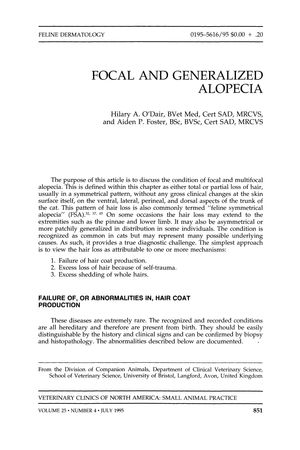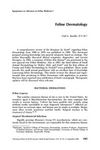Focal and Generalized Alopecia in Cats: Causes, Diagnosis, and Treatment
July 1995
in “
Veterinary Clinics of North America: Small Animal Practice
”
alopecia flea bite hypersensitivity atopy hereditary conditions allergies hyposensitization therapy mite infestations fungal infections dietary hypersensitivities psychogenic alopecia hormonal disorders feline endocrine alopecia thyroid-hormone therapy nutrient deficiencies demodicosis hair loss flea allergy allergy shots thyroid therapy

TLDR The document concludes that hair loss in cats is caused by various factors, including allergies, mites, infections, and hormonal issues, with treatments varying accordingly.
The 1995 document provides a comprehensive overview of the causes, diagnosis, and treatment of focal and generalized alopecia in cats. It identifies three main mechanisms for hair loss: failure of hair coat production, self-trauma due to excessive grooming, and excess shedding. The article highlights flea bite hypersensitivity as a major cause of symmetrical alopecia, responsible for about 75% of feline dermatitis cases at the authors' clinic, and discusses the role of atopy, hereditary conditions, and other allergies. It also mentions a study with 12 cats that showed a 45% success rate for hyposensitization therapy for allergies in the UK. Various mite infestations, fungal infections, dietary hypersensitivities, and psychogenic alopecia are discussed as potential causes of hair loss, with appropriate treatments suggested. The document also addresses hormonal disorders, noting that a clinical diagnosis of "feline endocrine alopecia" is often incorrect, as evidenced by a study of 20 cats with normal thyroid levels and another series where 19 out of 51 cats responded to thyroid-hormone therapy. Essential nutrient deficiencies are considered rare but possible contributors to skin and hair health issues. The need for further research on demodicosis in cats is emphasized, particularly regarding the life cycle and immune response.





